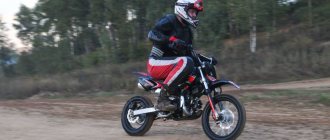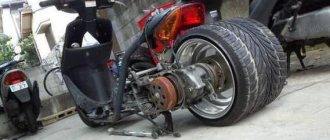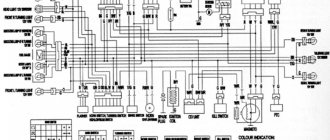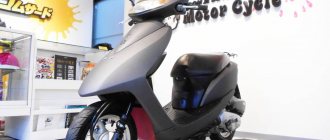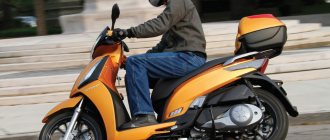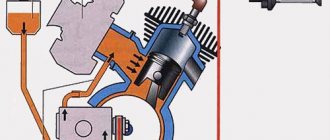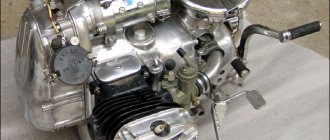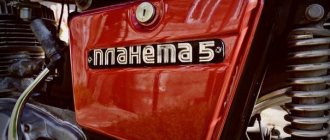Nexus Roar
Nexus Roar - photo 1
Nexus Roar - photo 2
Nexus Roar - photo 3
Nexus Roar - photo 4
Nexus Roar - photo 5
Nexus Roar modifications
Nexus Roar 250
| Maximum speed, km/h | 100 |
| Acceleration time to 100 km/h, sec | — |
| Engine | Gasoline carburetor |
| Number of cylinders / arrangement | 1 |
| Number of bars | 4 |
| Working volume, cm 3 | 249.8 |
| Power, hp / rpm | 16.6/6500 |
| Torque, N m / rpm | 19.5/5000 |
| Fuel consumption, l per 100 km | — |
| Curb weight, kg | 161 |
| Gearbox type | Variable speed drive |
| Cooling system | Liquid |
| Show all characteristics | |
Nexus XT250
Good day to all! I bought a Nexus XT250 motorcycle in June 2015 for 60,000 rubles. I used to drive Izhas, Javas, etc. the last time in 2001. I have traveled 600 km to date, in my opinion the price/quality exceeds expectations. Mostly asphalt and a little through the forest (light off-road). I ran it in gentle mode. From the very beginning I stretched everything, tied up and crimped all the wires, changed the oil at 50,300,500 km. MOTUL oil. Adjusted the carburetor. Bleeded the brakes. The chain is original, in principle it has not yet stretched, I regularly lubricate it with lubricant from a chain can. Several times the chain fell off in the forest when small branches got under it, I put it on without any problems, rolling the reel back. The original tires drive quite well on asphalt and hard ground, but very poorly on grass, in mud and loose ground. For trips through the forest I took a Kenda 19″ 70/100-19 K771F TT 42M for the front and a Kenda 17″ 4.60-17 K270 4PR TT 61P for the rear. The rear wheel rides great on gravel, broken asphalt, mud and sand. In front it’s the same, only you have to constantly fish on the sand (walks), perhaps because it’s too narrow. Overall I'm happy with the motorcycle. It drives fine, both on asphalt and dirt. I also ordered engine protection from Stels Enduro 250, I’ll install it in a week. If there are owners of these or similar motorcycles, please tell me: 1. How to change the oil in the fork, and what kind to fill (it seems to me that the fork has started to work worse, most likely the oil there is of very poor quality) 2. Who installed 100/90 off-road tires on the front R19 and which ones, does it stand up normally, does it touch or not, how does it behave on different surfaces, are there any other replacement options. 3. Rear shock absorber, who changed it to something better. 4. No one thought to install protective bars, what are they suitable for or maybe there is a drawing of homemade ones. Thanks in advance for your answers!
FakeHeader
Reviews from Nexus Roar owners
I rode this maxi-scooter for exactly 2 summers. It looks very solid and beautiful. Doesn't look like the typical "Chinese" with their ugly proportions. Appearance isn't the only thing I liked about the Nexus Roar. Very comfortable fit, the seat is wide, it’s very comfortable for me with my build to ride. The hands rest easily on the controls, the light is good (in general, the front end vaguely resembles the “Gold Wing”). But this is perhaps all its merits. The Nexus Roar has an outdated Honda engine, and the most annoying thing is that the Chinese managed to get only about 16 “horses” from the 250 cc. This, it seems to me, is very little. The chassis and brakes are basically normal, the plastic was surprisingly better than on Chinese counterparts. I think that Nexus Roar is worth the money, but nothing more.
Advantages
: appearance. Landing. Quality of plastic.
Flaws
: weak engine.
I have this device. What can I say, I switched from 150 ss China. In terms of comfort, the Nexus Roar 250 is much better. And so far there is nothing to say. I took it a week ago. I'm running it in. The engine is very quiet. With a helmet on, it feels like you're riding an electric scooter. This scooter is good, worth the money. The Nexus Roar 250 is as easy as an iron to maintain. Last season I covered 10,300 km on mine and now my (ex) scooter is traveling around Moscow. The new owner isn't complaining. During operation, I only strengthened the lower muffler mount and did not do anything serious with it.
Advantages
: reliable. Simple. Undemanding. Stylish.
Flaws
: minor damage.
Three times in three seasons I changed the centrifugal clutch, the price of which is 2500 rubles. (metal cheeks melt, there are three of them, and the springs that are responsible for their reverse movement come off). The first sign of spring separation is that the wheel spins during startup and at idle. This is the end, since the cheeks are not sold separately, urgently change the centrifugal clutch. But somehow you’ll get under way with the third one. Purchased as a whole. I didn't see any overheating on the sensor. In 2015, I changed the rear tire twice, I don’t know how it is with others, but the Nexus Roar 250 takes a fair amount of oil. It doesn't start well, sometimes really badly. I changed the spark plugs. Somehow the frame under the seat burst, and it was somehow strange, the weights were even heavier, but here I was riding alone, I felt my butt chattering, look, and there the engine was hanging. But I drove 15 km, wrapped it with wire and nothing, they welded it behind the “bubble”, ordinary metal, without argon. The bolts are not very good, the metal is bad from China, almost everything has been changed. So normal, the Nexus Roar 250 is worth the money, I bought it from scratch for 75,000 rubles. via the Internet in 2013, they brought it straight to the house. I sat down and drove off, running it in is a must.
Lexus HS250h engine
Lexus HS250h is a hybrid luxury car made in Japan. According to official information, the abbreviation HS stands for Harmonious Sedan, which means harmonious sedan. The car was created with concern for the environment, but at the same time it is able to provide acceptable dynamics for sports driving. To do this, the Lexus HS250h uses an inline four-cylinder internal combustion engine in conjunction with an electric motor.
Brief description of the car
The Lexus HS250h hybrid was first presented at the North American International Auto Show in January 2009. The car went on sale in July 2009 in Japan. A month later, sales began in the United States. The car became one of the first in the segment of luxury compact sedans with a hybrid power plant.
The Lexus HS250h is based on the Toyota Avensis. The car has a bright appearance and good aerodynamics. The car combines excellent comfort and practicality. Confident driving and perfect handling are ensured by the adaptive flexible independent suspension.
The interior of the Lexus HS250h is made using bioplastic of plant origin. It includes castor bean seeds and kenaf fiber. This made it possible to show concern for the environment and make the car “green”. The interior is quite spacious, and the seats for the driver and passengers are comfortable.
The car has a ton of highly functional electronics. The multimedia controller with touch controls turned out to be very convenient to use. The center console has a retractable screen. The graphical user interface is fully designed and provides access to a wide range of useful functions. The touchpad has haptic feedback for improved usability.
The safety of the Lexus HS250h is not inferior to comfort. The intelligent IHB system detects the presence of vehicles and adjusts the optics to prevent glare. Adaptive cruise control with LKA keeps the car in its lane. Lexus monitors driver drowsiness, detects collision risks and warns of obstacles along the way.
Engine under the hood of Lexus HS250h
Under the hood of the Lexus HS250h is a 2.4-liter 2AZ-FXE inline hybrid four-cylinder powertrain. The engine was selected to ensure sufficient dynamic performance without increasing fuel costs. The combustion engine and electric motor transmit torque to the CVT for a smoother driving experience. The power unit operates on the Atkinson cycle and provides acceptable acceleration to the sedan.
The 2AZ-FXE engine is very noisy. To drive at normal speed, you need to keep the revs high. At the same time, a unique roar comes from the engine, which the sound insulation cannot cope with. Car owners don’t like this too much, especially considering that the dynamics do not at all correspond to the volume of the power unit. Therefore, the Lexus HS250h with 2AZ-FXE is more suitable for measured city driving, where it behaves quietly and smoothly.
The 2AZ-FXE engine has an aluminum cylinder block. Cast iron sleeves are fused into the material. They have an uneven outer surface, which ensures their strong fixation and improves heat dissipation. A trochoid oil pump is installed in the crankcase. It is driven by an additional chain, which reduces the reliability of the power unit and increases the number of moving parts.
Another weak point in the design of the motor is the gears of the balancing mechanism. They are made of polymer material. This improved comfort and reduced engine noise, but led to frequent problems. Polymer gears quickly wear out and the engine loses its performance.
Technical characteristics of the power unit
The 2AZ-FXE engine has light-alloy pistons with a lightweight skirt, floating pins and an anti-friction polymer coating. The forged crankshaft is offset relative to the cylinder axes. The timing drive is carried out by a single-row chain. Other technical characteristics can be found in the table below.
Main technical characteristics of the 2AZ-FXE engine
| Parameter | Meaning |
| Number of cylinders | 4 |
| Number of valves | 16 |
| Exact volume | 2362 cm³ |
| Cylinder diameter | 88.5 mm |
| Piston stroke | 96 mm |
| Power | 130 - 150 hp |
| Torque | 142-190 N*m |
| Compression ratio | 12.5 |
| Fuel type | Gasoline AI-95 |
| Declared resource | 150 thousand km |
| Resource in practice | 250-300 thousand km |
The engine number for the 2AZ-FXE is located directly on the platform on the cylinder block. Its location is shown schematically in the image below. Traces of dust, dirt and rust can make it difficult to read the license plate number. To clean them, it is recommended to use a wire brush or rag.
Reliability and weaknesses
The 2AZ-FXE engine can hardly be called reliable. He has a number of design flaws that have led to problems of varying degrees of severity. Almost all car owners are faced with:
- progressive oil burner;
- pump leakage;
- sweating of seals and gaskets;
- unstable crankshaft speed;
- engine overheating.
Still, the main problem with engines is the spontaneous destruction of the threads in the cylinder block. Because of this, the cylinder head bolts fall out, the seal is broken and coolant leaks appear. In the future, this can lead to a violation of the geometry of the block itself and the cylinder head. Toyota recognized the design flaw and modified the threaded holes. In 2011, a repair kit for threaded bushings for repairs was released.
Motor maintainability
Officially, the manufacturer does not provide for a major overhaul of the 2AZ-FXE power unit. Low maintainability of engines is typical for most Lexus vehicles. 2AZ-FXE was no exception, therefore, if it has significant problems, the best way to solve the problem is to purchase a contract motor. At the same time, the low maintainability of the 2AZ-FXE is compensated by the high reliability of the power plant.
There are also difficulties in eliminating minor troubles. Original spare parts are often not available for sale. Therefore, it is recommended to treat the motor with care. It is important to perform maintenance on time and fill only with high-quality gasoline.
Tuning Lexus HS250h engines
The 2AZ-FXE engine is not particularly prone to tuning. Many car owners recommend starting modernization by replacing it with a more suitable one, for example, 2JZ-GTE. When deciding to tune the 2AZ-FXE, there are several main directions:
- chip tuning;
- modernization of related systems;
- superficial engine tuning;
- installation of a turbocharger;
- deep intervention.
Chip tuning can only slightly increase power. It removes the “stifling” of the engine by environmental standards from the factory. For a more significant result, a turbo kit is suitable. However, an insufficient safety margin of the cylinder block prevents a noticeable increase in power.
Spare parts for maxiscooters
Buy spare parts for Chinese and Russian maxiscooters with a volume of 250 cubic meters (172MM)
This section will present spare parts for the engine, chassis, and electrical systems for Chinese and Russian-made maxiscooters with a volume of 250 cc. Most often, such engines are marked on the crankcase as 172MM, and are installed on the following scooter models:
Jonway Ranger 250 Phantom 250 CF JET MAX 250 Viper Cruiser 250 Honda Foresight 250 Viper Tornado 250 Cronus Predator 250 Nexus Roar 250 Honling Adonis 250 Stels Caffenero 250 TRAMP MONARCH 250 TRAMP MAINSTREET 260 Zid-Lifan 250 and others.
Adapter for the second shock absorber for maxiscooter 4T CH250 (172MM) “KOMATCU”
Buy a second shock absorber bracket for a 250cc maxiscooter with a 172MM engine
Vacuum fuel pump for maxiscooter 4T CH250 (172MM) “KOMATCU”
Buy a vacuum fuel pump for a Chinese maxiscooter 250cc
Steering wheel button blocks for maxiscooter 4T CH250 (with hazard signal) “XVP”
Buy steering wheel button blocks for a maxiscooter with a volume of 250 cubic meters
Rear variator - clutch for maxiscooter 4T CH250 (172MM) "KOMATCU"
Buy a rear variator (centrifugal clutch) for a 250cc maxiscooter
Front variator assembly for maxiscooter 4T CH250 (172MM, + cheek and finger) “DONGXIN”
Buy a front variator assembly for a 250cc maxiscooter
Front variator assembly for maxi scooter Yamaha MAJESTY YP250, BRAVO 260 “DONGXIN”
Buy front variator assembly for maxiscooter 250 cc Yamaha MAJESTY YP250, BRAVO 260
Front variator assembly for maxi scooter Yamaha MAJESTY YP250, BRAVO 260 (+ finger) “DONGXIN”
Buy front variator assembly with pin for maxiscooter 250 cc Yamaha MAJESTY YP250, BRAVO 260
Front variator assembly for maxi scooter Yamaha MAJESTY YP250, BRAVO 260 (+ finger, cheek) “DONGXIN”
Buy a front variator assembly with pin and cheekpiece for maxiscooter 250 cc Yamaha MAJESTY YP250, BRAVO 260
Front variator for maxiscooter 4T CH250 (172MM, + finger) “DONGXIN”
Buy a front variator for a 250cc maxiscooter
Fan in bur with casing for radiator for maxiscooter 4T CH250 (172MM) “KOMATCU”
Buy a radiator fan for a 250cc maxiscooter
Fan in bur with casing for radiator for maxiscooter 4T CH250 (172MM) “SCHOUSE”
Buy a radiator fan for a 250cc maxiscooter
Muffler for maxiscooter 4T CH250 (172MM) “KOMATCU”
Buy an exhaust pipe - muffler for a 250cc maxiscooter
Cylinder head bare (without valves) for maxiscooter 4T CH250 (172MM) “KOMATCU”
Buy a cylinder head for a maxiscooter 250cc
Spare parts for engines
Faced with the need to repair a scooter engine and select spare parts for it, many drivers mistakenly search by the name of the motorbike model - but this is a pointless undertaking. In fact, spare parts need to be selected, paying attention to the type of engine and markings. What is marking? This is a set of numbers and letters printed on the surface of the motor; important data is encrypted in these designations.
For which engines can you buy spare parts?
In the Automotozip online store you can purchase all the necessary parts for the engine:
1. 50CC2T chain. Suitable for bikes with an engine capacity of 50 cubic meters (the designation CC is cubic centimeter), with a timing chain drive - motorcycle enthusiasts like the chain due to its long service life, the chain hardly wears out and rarely needs to be replaced “due to age”. 2T is a two-stroke engine; motorists value them for their excellent power, almost 2 times higher than in four-stroke engines with equal volumes. The design of 2T motors is simpler, there are fewer moving parts, so repairs are cheaper.
2. 50CC2T belt driven. Belts are convenient because they are insensitive to the quality of the engine oil used, lighten the overall weight of the engine, and operate silently. At the same time, motorcyclists should take into account that the resource of a rubber belt is limited - both by time and mileage, another significant drawback is that this part breaks instantly and most often unexpectedly. There is good news: changing belts is easy, you can do it yourself. Our online store has a good selection of belts for scooter engines; we recommend buying such parts with a reserve, especially since the price for such consumables is very affordable.
3. Spare parts for the 50-100cc 4T engine (139QMB). Volume up to 70 cubic meters. For four-stroke engines, which are quieter, the motorcycle starts smoothly, uses less fuel, and produces fewer emissions. Such engines are installed on massive scooter models. Now let's look at the 139QMB marking - what does it mean.
The first number is 1 cylinder.
39 is the diameter of the piston and piston rings or cylinder liner.
Q is a forced air cooling system. The first letter after the numbers tells you what kind of cooling is on the scooter.
M – indicates engine type – motorcycle.
B – volume up to 70 cubic meters.
4. Parts for 125-150CC scooter engine. The volume is 150 cubic meters, which means that such scooters reach higher speeds. Many Chinese scooters are equipped with similar engines: Honling, Geely, Vento, Zongshen, Nexus, Baotian - and dozens more models; the motorcyclist’s task is to pay attention to the markings.
The numbers are unchanged: one cylinder, 57 mm cylinder or piston diameter.
Q – air cooling.
M is for motorcycles.
J is the volume, which is equal to 150-155 cubic meters.
152QMI – here we will decipher only the last letter, I – this is 120-130 cubic meters.
5. Spare parts for a scooter for a 250CC engine - volume 250 cubic cm. Such motorbikes are also called maxiscooters - they are almost a motorcycle. Such engines can be found on Phantom, Viper Cruiser, Nexus Roar, Honda Foresight, Viper Tornado and more.
One motor for different bike models
As you can see, there are not many types of engines and it is not difficult to understand this issue. Every year, Chinese manufacturers release new models of scooters, the appearance and technical characteristics of which are constantly changing, but the “heart” - the motor - remains unchanged. If your scooter has a different marking, you can contact our sales managers for help, we will guide you to the appropriate parts.
© 2013-2021 AutomotoZIP, All rights reserved.
Nexus Roar
Nexus Roar - photo 1
Nexus Roar - photo 2
Nexus Roar - photo 3
Nexus Roar - photo 4
Nexus Roar - photo 5
Nexus Roar Specifications
| Model year | 2018 |
| Type | Scooter |
| Class | Scooter maxi |
| Length, mm | 2145 |
| Width, mm | 740 |
| Height, mm | 1240 |
| Seat height, mm | 810 |
| Guarantee | 1 year |
| Country of assembly | China |
Nexus Roar modifications
Nexus Roar 250
| Maximum speed, km/h | 100 |
| Acceleration time to 100 km/h, sec | — |
| Engine | Gasoline carburetor |
| Number of cylinders / arrangement | 1 |
| Number of bars | 4 |
| Working volume, cm 3 | 249.8 |
| Power, hp / rpm | 16.6/6500 |
| Torque, N m / rpm | 19.5/5000 |
| Fuel consumption, l per 100 km | — |
| Curb weight, kg | 161 |
| Gearbox type | Variable speed drive |
| Cooling system | Liquid |
| Show all characteristics | |
scooter Nexus Roar white /Code 55-92006
- Information
- More
Specifications
| Engine | |
| Ignition | Electronic CDI |
| Engine starting | electric starter |
| Engine power (hp) | 14.96 |
| Working volume (cm. cubic meters) | 250 |
| engine's type | 4 stroke |
| Performance indicators | |
| Fuel | AI-92 |
| Fuel supply | carburetor |
| Fuel tank volume | 8.5 |
| Transmission | |
| Transmission | Variable speed drive |
| Dimensions and Weight | |
| Weight, kg) | 153 |
| Dimensions (L x W x H, mm) | 2 140 / 740 / 1 213 |
| Suspension | |
| Front suspension | telescopic fork |
| Rear suspension | pendulum with two shock absorbers |
| Brake system | |
| Front brake | Disk |
| Rear brake | Disk |
| Brake type | Disk |
| Wheels | |
| Front wheel (tires) | R13 |
| Rear wheel (tires) | R13 |
| Main characteristics | |
| Year of manufacture (year) | 2016 |
| Country of Origin | China |
| Maximum speed (km/h) | 50 |
Engine: 250 cm3 4-stroke 14.96 hp (11.00 kW)
Max. speed: 50 km/h
- Scooter Nexus Booster
- Scooter Nexus F35 50cc
Would you like to leave your feedback?
Catalog brands
- home
- Blog
- Delivery
- Payment
- Contacts
- Working hours:
Mon-Fri: 08:00-20:00, Sat-Sun: 10:00-18:00 - Address:
Moscow, Brateevskaya st., building 21, bldg. 4B
Outdoor equipment store © 2014 - 2022 WildFlight LLC.
This information resource is not a public offer. The availability and cost of goods please call. Manufacturers reserve the right to change the technical specifications and appearance of products without prior notice. Site Map

